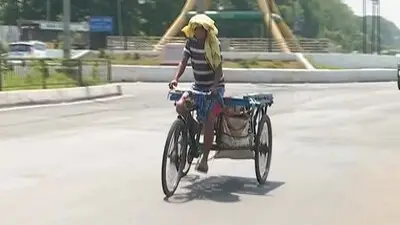The operator, Tokyo Electric Power Company (TEPCO), said the worker has no health problems so far and will be seen by a doctor tomorrow.
The woman in her 40s was exposed to a total of 7.49 millisieverts of radiation, against the legal limit for female workers of 5 millisieverts for a three-month period, when she was working at the six-reactor complex following the March 11 earthquake and tsunami, TEPCO was quoted as saying by Kyodo.
The woman was working at an in-house medical office of the Fukushima plant until March 15, four days after the twin disaster, following which she was moved to another office within Fukushima Prefecture.
TEPCO said it is the second case of a female worker being exposed to radiation exceeding the legal limit, and that no woman has been allowed to work at the plant since March 23, according to national broadcaster NHK.
Separately, Japan`s Health Ministry said it has detected a minute amount of radiation in breast milk samples of seven mothers in central and northeastern Japan.
It said the radiation level does not pose a danger to their babies` health.
The ministry yesterday released the results of a study conducted in Fukushima, Tokyo and three other prefectures in Kanto region from last Sunday through Thursday.
The ministry said the breast milk samples from a mother in Iwaki city of Fukushima Prefecture contained 3.5 becquerels of radioactive iodine per litre and 2.4 becquerels of radioactive cesium per litre, NHK said.
Up to 2.8 becquerels of radioactive material per litre was also detected in six mothers in two other prefectures.
Japan has no regulatory levels to determine the health risk from radioactive substances in breast milk. But it sets the safety levels for babies` consumption of milk and drinking water at 100 becquerels of radioactive iodine per litre and 200 becquerels of radioactive cesium per litre.
Meanwhile, TEPCO said it is going to implement new measures at the disaster-hit Fukushima Daiichi nuclear plant to protect it from any other tsunami or aftershocks. The work will be completed by late July.
A utility official said yesterday that TEPCO is going to build 12-metre-high temporary levees consisting of stone-filled baskets to protect the plant from any tsunami.
The power company will also fill in the pits leading down to the four tunnels on the ocean side of the No.2 and No.3 reactors with concrete to prevent highly radioactive water from leaking into the sea.
As a measure to protect the plant from aftershocks, TEPCO will set up a steel pillar at the bottom of the spent-fuel storage pool of the No.4 reactor and solidify it with concrete.
A hydrogen explosion last month had damaged the wall of the reactor building, weakening its quake resistance.
Goshi Hosono, an adviser to Premier Naoto Kan and senior member of the government`s nuclear taskforce, said a magnitude 8 aftershock may occur off the coast where the plant is located.
TEPCO is also studying the possibility of sending more employees and former workers to the plant.
People who have previously worked at the plant and who have been trained in nuclear-related matters, such as radiation monitoring, are the potential candidates. About 3,000 people are believed to qualify, NHK said.
About 1,000 workers of TEPCO and its contract companies are currently working at the power plant to bring it under control.
The company is still struggling to stabilise the plant, over seven weeks after the magnitude-9 quake and tsunami left more than 25,000 people dead or missing in Japan`s northeast.
According to the National Police Agency, 14,662 people have been confirmed dead, including those who were killed in aftershocks on April 7 and 11, while 11,019 are listed as missing.
More than 127,000 people are still living in evacuation centres, most of them in the three prefectures of Miyagi, Iwate and Fukushima.












